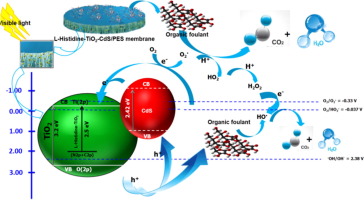Separation and Purification Technology ( IF 8.1 ) Pub Date : 2020-01-18 , DOI: 10.1016/j.seppur.2020.116591 Hadis Zangeneh , Ali Akbar Zinatizadeh , Sirus Zinadini

|
The polyethersulfone (PES) membrane incorporated with L-Histidine doped TiO2-CdS photocatalytic nanocomposite is fabricated to improve the membrane performance and its antifouling properties. The L-Histidine doped TiO2-CdS/PES nanofiltration membrane was characterized by scanning electron microscopy (SEM), contact angle and atomic force analysis (AFM) analyses. SEM images and contact angle results are demonstrated that membrane porosity and its hydrophilic properties increase with adding of L-Histidine doped TiO2-CdS photocatalytic nanocomposite. Moreover, AFM images of the modified membranes indicate favorable changes in surface roughness resulting in the improvement of antifouling properties. The pure water flux, flux recovery ratio (FRR) during filtration of milk powder and activated sludge suspension were also measured in a dead end cell. Increasing membrane permeability and FRR value approved its effective role of the added nanoparticles into the PES matrix. The M3 (0.5 wt. % of NPs) membrane is selected as an optimal nanocomposite membrane which exhibits a much higher pure water flux (42.1 kg/m2.h) and FRR value (90 and 97 % during filtration of milk powder and activated sludge suspension, respectively). The photocatalytic capability and antifouling properties of the M3 membrane as an optimum membrane were also investigated in a cross flow cell under continuous visible light irradiation. As a result, the high permeation flux (34.7 kg/m2.h), COD removal (100 %) and FRR value (99 %) was achieved during filtration of biologically treated palm oil mill effluent (POME) with COD concentration of 1000 mg/L at feed flow rate of 150 L/h and pressure of 5 bar. Effect of feed flow rate (50 and 150 L/h) and COD concentration (1000, 3000 and 5000 mg/L) on the membrane performance and its fouling resistance was also evaluated. Increasing feed concentration shows a negative effect on the membrane performance while feed flow rate increases separation performance and self-cleaning properties of the M3 membrane.
中文翻译:

L-组氨酸掺杂的TiO 2 -CdS / PES纳米复合膜的自清洁性能:制备,表征和性能
制备了掺有L-组氨酸掺杂的TiO 2 -CdS光催化纳米复合材料的聚醚砜(PES)膜,以提高膜性能及其防污性能。通过扫描电子显微镜(SEM),接触角和原子力分析(AFM)分析对L-组氨酸掺杂的TiO 2 -CdS / PES纳滤膜进行了表征。SEM图像和接触角结果表明,添加L-组氨酸掺杂的TiO 2可以提高膜的孔隙率和亲水性。-CdS光催化纳米复合材料。而且,改性膜的AFM图像表明表面粗糙度的有利变化,导致防污性能的改善。还测量了死角池中的纯水通量,奶粉过滤过程中的通量回收率(FRR)和活性污泥悬浮液。膜渗透性和FRR值的提高证明了将纳米颗粒添加到PES基质中的有效作用。选择M 3(NP的0.5 wt。%)膜作为最佳纳米复合膜,该膜表现出更高的纯净水通量(42.1 kg / m 2 .h)和FRR值(在过滤奶粉和牛奶时分别为90%和97%)活性污泥悬浮液)。M 3的光催化能力和防污性能还在连续流动池中在连续可见光照射下研究了作为最佳膜的膜。结果,在经过生物处理的棕榈油厂出水(POME)的COD浓度为1000的过滤过程中,实现了高渗透通量(34.7 kg / m 2 .h),COD去除(100%)和FRR值(99%)。进料流量为150 L / h,压力为5 bar时为mg / L。还评估了进料流速(50和150 L / h)和COD浓度(1000、3000和5000 mg / L)对膜性能及其耐污染性的影响。进料浓度的增加显示了对膜性能的负面影响,而进料流速则增加了M 3膜的分离性能和自清洁性能。










































 京公网安备 11010802027423号
京公网安备 11010802027423号